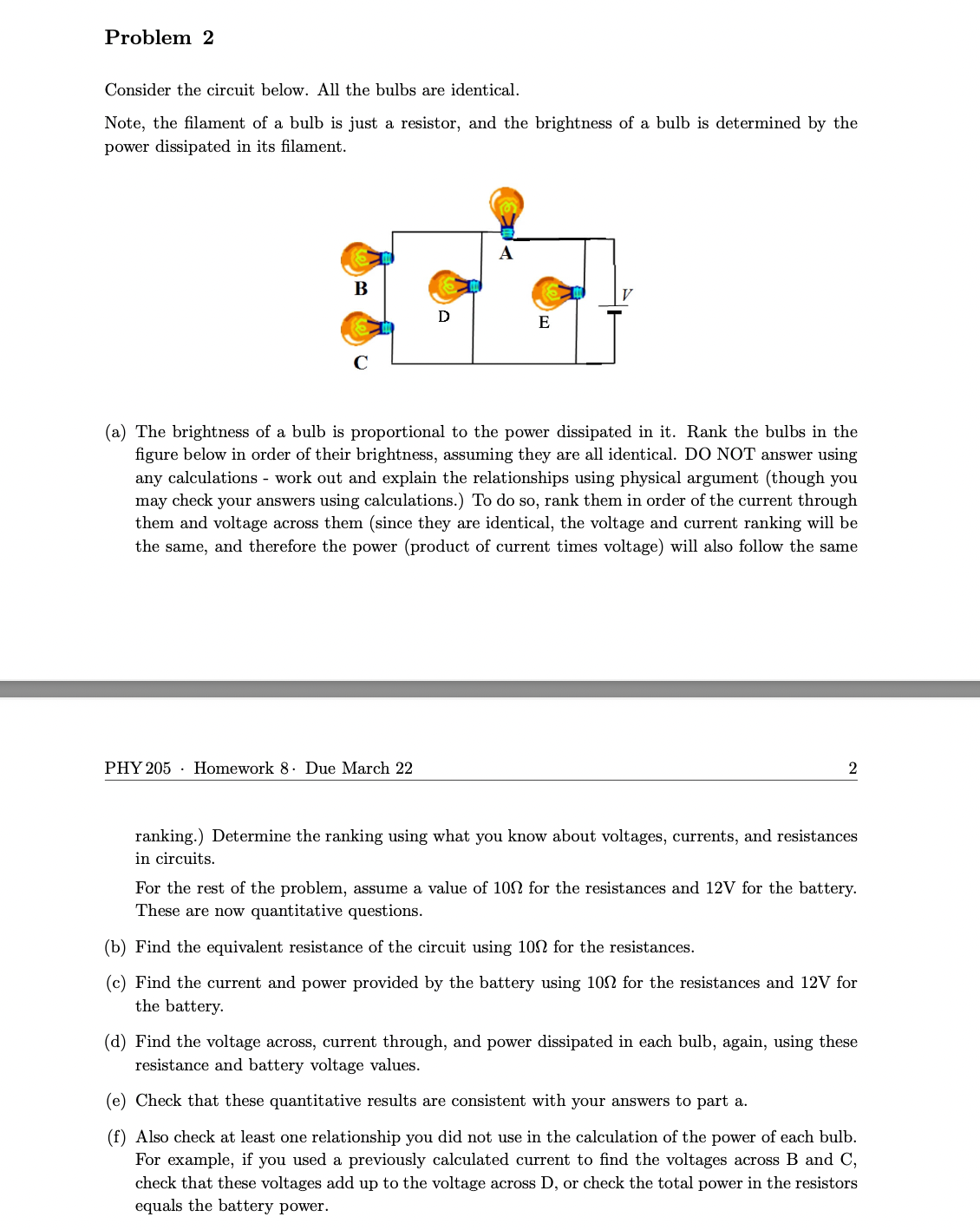Problem 2 Consider the circuit below. All the bulbs are identical. Note, the filament of a bulb is just a resistor, and the brightness of a bulb is determined by the power dissipated in its filament. B C D PHY 205 Homework 8. Due March 22 A E (a) The brightness of a bulb is proportional to the power dissipated in it. Rank the bulbs in the figure below in order of their brightness, assuming they are all identical. DO NOT answer using any calculations - work out and explain the relationships using physical argument (though you may check your answers using calculations.) To do so, rank them in order of the current through them and voltage across them (since they are identical, the voltage and current ranking will be the same, and therefore the power (product of current times voltage) will also follow the same 2 ranking.) Determine the ranking using what you know about voltages, currents, and resistances in circuits. For the rest of the problem, assume a value of 100 for the resistances and 12V for the battery. These are now quantitative questions. (b) Find the equivalent resistance of the circuit using 100 for the resistances. (c) Find the current and power provided by the battery using 100 for the resistances and 12V for the battery.
Problem 2 Consider the circuit below. All the bulbs are identical. Note, the filament of a bulb is just a resistor, and the brightness of a bulb is determined by the power dissipated in its filament. B C D PHY 205 Homework 8. Due March 22 A E (a) The brightness of a bulb is proportional to the power dissipated in it. Rank the bulbs in the figure below in order of their brightness, assuming they are all identical. DO NOT answer using any calculations - work out and explain the relationships using physical argument (though you may check your answers using calculations.) To do so, rank them in order of the current through them and voltage across them (since they are identical, the voltage and current ranking will be the same, and therefore the power (product of current times voltage) will also follow the same 2 ranking.) Determine the ranking using what you know about voltages, currents, and resistances in circuits. For the rest of the problem, assume a value of 100 for the resistances and 12V for the battery. These are now quantitative questions. (b) Find the equivalent resistance of the circuit using 100 for the resistances. (c) Find the current and power provided by the battery using 100 for the resistances and 12V for the battery.
Chapter7: Electricity
Section: Chapter Questions
Problem 15Q: (Indicates a review question, which means it requires only a basic understanding of the material to...
Related questions
Question
a-c would be much appreciated

Transcribed Image Text:Problem 2
Consider the circuit below. All the bulbs are identical.
Note, the filament of a bulb is just a resistor, and the brightness of a bulb is determined by the
power dissipated in its filament.
B
C
D
PHY 205 Homework 8. Due March 22
A
E
(a) The brightness of a bulb is proportional to the power dissipated in it. Rank the bulbs in the
figure below in order of their brightness, assuming they are all identical. DO NOT answer using
any calculations - work out and explain the relationships using physical argument (though you
may check your answers using calculations.) To do so, rank them in order of the current through
them and voltage across them (since they are identical, the voltage and current ranking will be
the same, and therefore the power (product of current times voltage) will also follow the same
2
ranking.) Determine the ranking using what you know about voltages, currents, and resistances
in circuits.
For the rest of the problem, assume a value of 100 for the resistances and 12V for the battery.
These are now quantitative questions.
(b) Find the equivalent resistance of the circuit using 100 for the resistances.
(c) Find the current and power provided by the battery using 10 for the resistances and 12V for
the battery.
(d) Find the voltage across, current through, and power dissipated in each bulb, again, using these
resistance and battery voltage values.
(e) Check that these quantitative results are consistent with your answers to part a.
(f) Also check at least one relationship you did not use in the calculation of the power of each bulb.
For example, if you used a previously calculated current to find the voltages across B and C,
check that these voltages add up to the voltage across D, or check the total power in the resistors
equals the battery power.
Expert Solution
This question has been solved!
Explore an expertly crafted, step-by-step solution for a thorough understanding of key concepts.
This is a popular solution!
Trending now
This is a popular solution!
Step by step
Solved in 2 steps with 1 images

Follow-up Questions
Read through expert solutions to related follow-up questions below.
Knowledge Booster
Learn more about
Need a deep-dive on the concept behind this application? Look no further. Learn more about this topic, physics and related others by exploring similar questions and additional content below.Recommended textbooks for you


College Physics
Physics
ISBN:
9781938168000
Author:
Paul Peter Urone, Roger Hinrichs
Publisher:
OpenStax College

Physics for Scientists and Engineers: Foundations…
Physics
ISBN:
9781133939146
Author:
Katz, Debora M.
Publisher:
Cengage Learning


College Physics
Physics
ISBN:
9781938168000
Author:
Paul Peter Urone, Roger Hinrichs
Publisher:
OpenStax College

Physics for Scientists and Engineers: Foundations…
Physics
ISBN:
9781133939146
Author:
Katz, Debora M.
Publisher:
Cengage Learning
